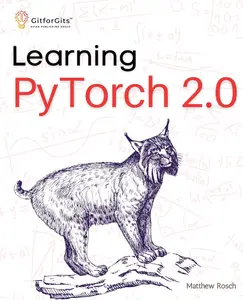Learning PyTorch 2.0 Experiment deep learning from basics to complex models using every potential capability

Free Download Learning PyTorch 2.0: Experiment deep learning from basics to complex models using every potential capability of Pythonic PyTorch by Matthew Rosch
English | July 1, 2023 | ISBN: 8196288379 | 146 pages | EPUB | 0.16 Mb
This book is a comprehensive guide to understanding and utilizing PyTorch 2.0 for deep learning applications. It starts with an introduction to PyTorch, its various advantages over other deep learning frameworks, and its blend with CUDA for GPU acceleration. We delve into the heart of PyTorch – tensors, learning their different types, properties, and operations. Through step-by-step examples, the reader learns to perform basic arithmetic operations on tensors, manipulate them, and understand errors related to tensor shapes.
A substantial portion of the book is dedicated to illustrating how to build simple PyTorch models. This includes uploading and preparing datasets, defining the architecture, training, and predicting. It provides hands-on exercises with a real-world dataset. The book then dives into exploring PyTorch’s nn module and gives a detailed comparison of different types of networks like Feedforward, RNN, GRU, CNN, and their combination.
Further, the book delves into understanding the training process and PyTorch’s optim module. It explores the overview of optimization algorithms like Gradient Descent, SGD, Mini-batch Gradient Descent, Momentum, Adagrad, and Adam. A separate chapter focuses on advanced concepts in PyTorch 2.0, like model serialization, optimization, distributed training, and PyTorch Quantization API.
In the final chapters, the book discusses the differences between TensorFlow 2.0 and PyTorch 2.0 and the step-by-step process of migrating a TensorFlow model to PyTorch 2.0 using ONNX. It provides an overview of common issues encountered during this process and how to resolve them.
Key LearningsA comprehensive introduction to PyTorch and CUDA for deep learning.Detailed understanding and operations on PyTorch tensors.Step-by-step guide to building simple PyTorch models.Insight into PyTorch’s nn module and comparison of various network types.Overview of the training process and exploration of PyTorch’s optim module.Understanding advanced concepts in PyTorch like model serialization and optimization.Knowledge of distributed training in PyTorch.Practical guide to using PyTorch’s Quantization API.Differences between TensorFlow 2.0 and PyTorch 2.0.Guidance on migrating TensorFlow models to PyTorch using ONNX.
Table of ContentIntroduction to Pytorch 2.0 and CUDA 11.8Getting Started with TensorsAdvanced Tensors OperationsBuilding Neural Networks with PyTorch 2.0Training Neural Networks in PyTorch 2.0PyTorch 2.0 AdvancedMigrating from TensorFlow to PyTorch 2.0End-to-End PyTorch Regression Model
Audience
A perfect and skillful book for every machine learning engineer, data scientist, AI engineer and data researcher who are passionately looking towards drawing actionable intelligence using PyTorch 2.0. Knowing Python and the basics of deep learning is all you need to sail through this book.
